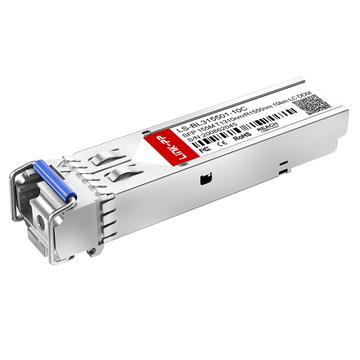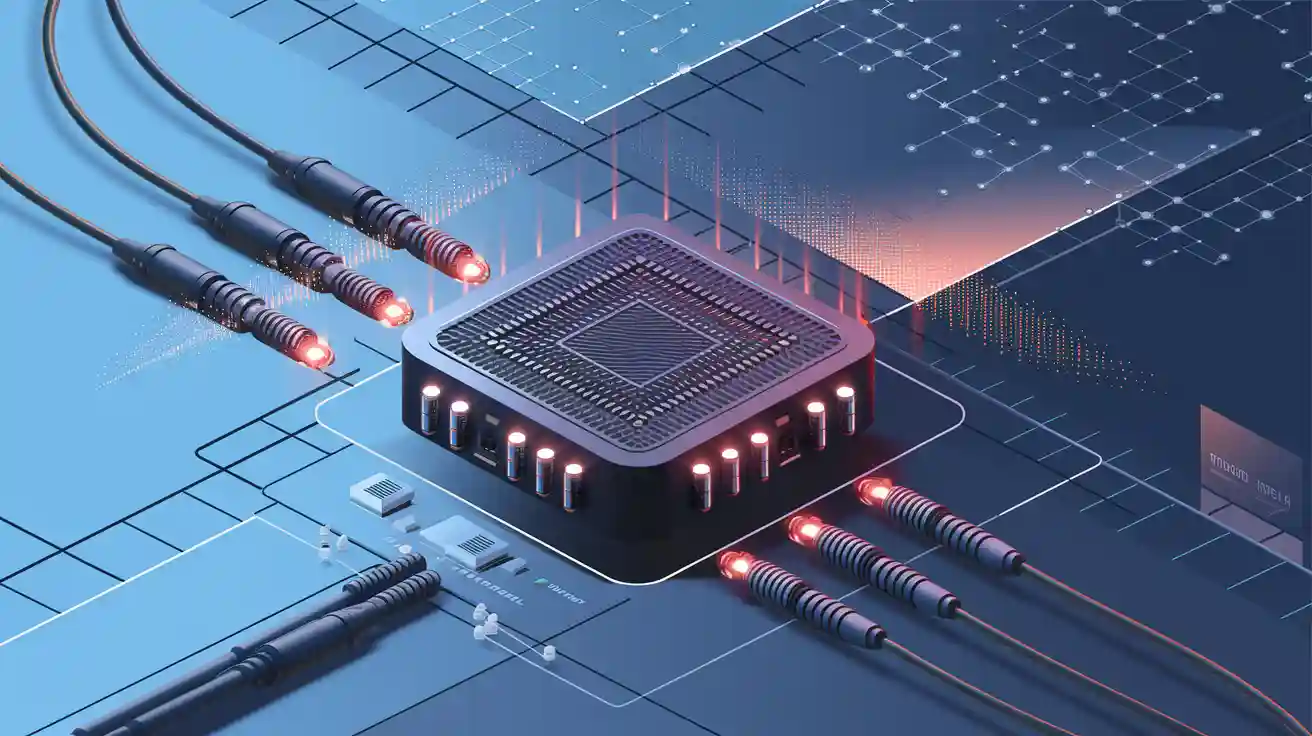
An optical module is an important part of today’s data systems. It helps send data using light signals through fiber optic cables. This technology is crucial for fast and reliable data transfer in networks.
The need for optical modules has grown because of faster data demands. For example:
The global DWDM Optical Module market may grow from $3.5 billion in 2023 to $8.9 billion by 2032, with an 11% yearly growth rate.
Optical transceivers solve problems with old copper methods by offering high-speed, low-delay data transfer. This is important for cloud services, video streaming, and smart devices.
These improvements make optical modules a must-have for modern networks.
Key Takeaways
Optical modules use light to send data quickly and reliably.
There are different types, like SFP and QSFP, for various uses.
They work for short distances or fast data transfers.
Picking the right module depends on distance, speed, and system fit.
Optical modules save energy and lower costs for growing networks.
Industries like telecom, healthcare, and cloud computing depend on them.
What Is an Optical Module?
Definition and basic explanation
An optical module is a small device that moves data using light. It changes electrical signals into light signals and back again. This helps data travel faster and farther than with copper cables. Optical modules are very important for fast internet, cloud computing, and other data-heavy tasks.
Different industries use optical modules in unique ways. For example:
Standard | Description |
|---|---|
InfiniBand | Used in powerful computers to connect systems, relying on optical modules. |
Fibre Channel | Links storage to servers with fiber cables, using optical modules. |
Ethernet | Connects networks like LAN and WAN, using optical modules for faster speeds. |
These examples show how flexible and useful optical modules are in many networks.
Key components of an optical module
An optical module has several parts that work together to send data. These include:
Transmitter: Changes electrical signals into light signals.
Receiver: Changes light signals back into electrical signals.
Laser Diode: Makes the light for sending data.
Photodetector: Reads light signals and turns them into electrical signals.
Connector: Attaches the module to fiber optic cables.
Technical guides, like "TI DLP® System Design: Optical Module Specifications," explain these parts in detail. The laser diode creates accurate light, while the photodetector ensures signals are received correctly.
Overview of its role in data transmission
Optical modules help networks send data quickly and reliably. They handle large amounts of data with little delay. For example:
200G QSFP-DD transceivers increase bandwidth for modern needs.
They allow more connections in data centers without extra equipment.
Low delay makes them great for cloud computing and big data.
One company used QSFP-DD breakout cables to manage data better. This saved money by using ports efficiently and improved network performance. Optical modules help networks keep up with today’s data needs.
How Does an Optical Module Work?
How data moves using light signals
An optical module sends data as light through fiber cables. Light is faster than electricity, making it great for quick communication. The module turns data into light flashes that travel without problems. This method ensures data moves far and reliably.
Studies prove how well light signals work in optical modules. For example:
Study Title | Focus | Findings |
|---|---|---|
Comparing regular and spatial optical transmitters with CWDM tech | Efficiency of optical transmitters | Shows how light signals are effective |
Studying how weather affects FSO–WDM systems for long distances | Weather effects on light signals | Explains how the environment impacts long-range signals |
These studies show why light signals are key for modern networks.
Changing electrical signals to light and back again
Optical modules change electrical signals into light and then back again. This process is called photoelectric conversion and is needed for data transfer. The transmitter turns electrical signals into light. The receiver changes the light back into electrical signals.
This process keeps data moving smoothly in networks. For instance, power tools like the MPM38x4C series improve voltage changes. This helps optical modules work better and handle more data traffic.
Transceivers in optical modules, like LINK-PP's Cisco SFP module
Transceivers are important parts of optical modules. They send and receive data for smooth communication. LINK-PP's Cisco ONS-SE-100-BX10U-D Compatible LS-BL315501-10C SFP module is a good example. It supports 155Mbps speeds and works up to 10km, perfect for long distances.
This module uses a Simplex LC connector and works at 1310nm for sending and 1550nm for receiving. Its Digital Optical Monitoring (DOM) feature checks performance in real-time, making it reliable. With advanced tech, this transceiver offers efficient and affordable networking.
Types of Optical Modules
SFP (Small Form-factor Pluggable)
SFP modules are small and very common in networks. They are hot-swappable, so you can replace them without turning off systems. This is helpful for places where constant operation is important. SFP modules work with different speeds, distances, and wavelengths, making them useful for many tasks.
For example, SFP modules fit with devices like switches and routers. They also have Digital Diagnostics Monitoring (DDM). This feature lets you check power, temperature, and other details in real time. These abilities make SFP modules reliable for businesses and data centers.
QSFP (Quad Small Form-factor Pluggable)
QSFP modules are made for fast networks. They handle speeds up to 400Gbps, which is great for big data centers and cloud systems. QSFP modules combine four channels into one to send more data.
Tests show how well QSFP modules work in fast networks. For example:
Test Type | What It Checks |
|---|---|
Optical Spectrum Test | Makes sure signals are clear by checking wavelengths. |
Bit Error Rate Test | Finds errors and uses FEC tech to improve signals. |
Temperature Test | Ensures the module works well in different temperatures. |
These tests prove QSFP modules are strong and efficient for tough jobs.
Other types such as CFP, XFP, and SFP28
Other optical modules, like CFP, XFP, and SFP28, have special uses. CFP modules are bigger and handle very fast networks, often used in telecoms. XFP modules are older but still good for 10Gbps networks.
SFP28 modules are faster versions of SFP, supporting 25Gbps speeds. They are great for modern data centers needing faster links without big upgrades. Each type of module has a specific job, so you can pick the best one for your network.
Differences between these types and their use cases.
Knowing the differences between optical modules helps you pick the right one. Each type has special features and works for specific tasks.
SFP Modules
SFP modules are small and flexible. They support speeds up to 1Gbps and work for short or medium distances. These modules connect switches and routers in business networks. You can replace them without turning off systems, which is great for places needing constant operation.QSFP Modules
QSFP modules are faster, handling speeds from 40Gbps to 400Gbps. They combine several data channels into one, saving space and power. These modules are perfect for big data centers and cloud systems. If your network needs to handle a lot of data, QSFP modules are a smart choice.CFP and XFP Modules
CFP modules are bigger and made for very fast networks like telecoms. They support speeds up to 100Gbps and work well over long distances. XFP modules are older but still good for 10Gbps networks. They are often used in older systems that don’t need upgrades.SFP28 Modules
SFP28 modules are faster versions of SFP. They support speeds up to 25Gbps and are great for modern data centers. These modules give faster connections without needing big changes to the system.
Managing heat is important for optical modules. For example, Multi-Source Agreements (MSAs) set rules for power and speed, ensuring different brands work together. High-power modules, like QSFP, need better cooling to perform well. This makes heat control a key part of choosing modules for fast networks.
By learning these differences, you can pick the best module for your needs. Whether you need speed, distance, or compatibility, there’s a module that fits your network.
Applications of Optical Modules
Telecommunications industry
Optical modules are key in the telecom industry. They help send data quickly, which is needed for modern networks. With 5G growing, these modules provide fast speeds and low delays. They also support long-distance data transfer for metro and underwater cables.
The need for optical modules in telecom keeps increasing. For example:
Faster data needs are growing the optical transceiver market.
Telecom networks use them for strong, long-distance connections.
They are vital for 5G, offering fast communication with little delay.
Segment | Market Share (2024) | Growth Rate (2024-2029) | Key Drivers |
|---|---|---|---|
15% | Fast data, cloud computing, AI, 5G, and lower costs. | ||
Telecommunications | N/A | N/A | Needed for networks, supports high-speed, low-delay links. |
Data centers and cloud computing
Data centers need optical modules for fast data storage and sharing. These modules make cloud computing quicker and more efficient. Using advanced optical transceivers saves energy and lowers costs.
Key performance measures show how optical modules help cloud computing:
KPI | Short-term Impact | Medium-term Impact | Long-term Impact |
|---|---|---|---|
Data Transmission Rates | Use of 400G and 800G transceivers | 1.6T and 3.2T links become common | Over 10T per channel in real use |
Energy Efficiency | 30% energy saved in early projects | 50% less energy used overall | Almost no carbon footprint in big centers |
Cost Metrics | Costs drop to 20% of electronic systems | Costs match electronics for most uses | 50% lower total ownership cost |
These improvements make optical modules essential for data centers today.
Enterprise networks
Optical modules improve business networks with fast and reliable connections. As companies use cloud, IoT, and AI, they need better data transfer. Optical modules meet these needs with high-speed solutions.
Many industries benefit from optical modules:
Banks use them for secure and quick transactions.
Hospitals depend on them for live data sharing and telemedicine.
Schools use them for online classes and research.
Businesses rely more on optical modules to boost network speed and growth. This shows how important digital tools are for modern companies.
Other industries such as healthcare and military.
Optical modules are important for healthcare and military work. These fields need fast and safe ways to share data. Optical modules give the tools to meet these needs.
In healthcare, optical modules help advanced medical systems work well. Hospitals use them to link imaging devices, patient monitors, and health records. During surgeries, doctors need instant data from imaging tools. Optical modules make sure this data arrives quickly. Telemedicine also uses optical modules. They allow clear video calls between doctors and patients, even far away. This helps more people get care and saves lives.
The military uses optical modules for secure communication. Military missions need quick and reliable data sharing over long distances. Optical modules send encrypted information between command centers, vehicles, and field teams. They also work with radar and surveillance tools. For example, drones with optical modules send live video to operators. This helps leaders make smart choices during missions.
Tip: Optical modules are key for jobs needing speed, safety, and reliability. They keep data moving smoothly in tough situations.
Both industries like how optical modules can grow with their needs. Networks can be upgraded without replacing everything. This saves money and meets growing demands. Whether helping hospitals or protecting nations, optical modules are vital for critical tasks.
By learning their uses, you see how optical modules help beyond regular networks. Their flexibility makes them a big part of future technology.
Benefits of Using Optical Modules
High-speed data transmission
Optical modules send data very fast, making networks work better. They can handle speeds up to 25.78125 Gb/s. These modules follow rules like IEEE 802.3cc and SFF-8472, so they fit many systems. They send data over long distances, up to 80 km, using single-mode fiber. This makes them great for both short and long connections.
Feature | Details |
|---|---|
Data Rate | Up to 25.78125 Gb/s |
Compliance | IEEE 802.3cc, SFF-8472, SFF-8419 |
Operating Temperature Range | 0°C to 70°C (normal), -40°C to 85°C (industrial) |
Transmission Distance | Up to 80 km with G.652 single mode fiber |
Technology | Two-way data transfer using WDM |
These features make optical modules perfect for cloud computing, video streaming, and business networks needing fast data.
Energy efficiency and cost-effectiveness
Optical modules save energy and cut costs while boosting performance. Studies show they reduce the number of fibers needed in networks. This delays adding new fibers, saving money on infrastructure. You can grow your network step by step, adding resources only when needed. This makes optical modules a smart and affordable choice for expanding networks.
They also use less power than copper systems, helping save energy. This makes them eco-friendly for businesses wanting to lower their carbon footprint. Optical modules are both efficient and good for the environment.
Scalability and flexibility in network design
Optical modules help networks grow and adapt to new needs. For example, a financial company improved its data center using these modules. Data centers ready for 800G speeds use them to add new tech easily. A global network operator used optical modules to create a flexible system for growing data traffic.
A financial company scaled its data center with optical modules.
800G-ready centers use them to adopt advanced technologies.
A global operator built a flexible network with optical modules.
These examples show how optical modules help build networks that grow and stay efficient over time.
Better reliability and less delay.
Optical modules help networks work well and stay reliable. They handle lots of data without slowing down, even in tough conditions. These devices use smart technology to avoid signal problems and keep communication smooth.
One reason optical modules are reliable is their efficiency. For example:
Proof | Details |
|---|---|
90% Efficiency | The NPG102 family works at over 90% efficiency with less than 0.5 dB loss in laser coupling. This lowers risks and keeps performance steady. |
Mass Production | Built-in lasers make production easier, ensuring good performance for large-scale use. |
These features make optical modules trustworthy for all kinds of networks.
How to Choose the Right Optical Module
Things to think about (like compatibility, speed, and distance)
Picking the right optical module means looking at key details. You need to know what your network needs to work well. Here are some simple points to check:
Distance and Bandwidth: Use single-mode (SM) SFPs for long-distance links. Multimode (MM) SFPs are better for fast, short-distance connections.
Connector Type: Make sure the connector matches your current setup.
Expected Throughput: Check if the module can handle your data needs.
Operating Conditions: Think about the temperature and environment where it will be used.
For short distances, Direct Attach Cables (DAC) save money. For longer distances with less delay, Active Optical Cables (AOC) work better. By checking these details, you can find the best optical module for your network.
Why knowing your network matters
Knowing your network’s needs helps you pick the right optical module. Networks are different based on size, purpose, and equipment. For example, small businesses may want cheaper options. Data centers might need fast and scalable solutions.
Think about the type of data your network handles. Video streaming or cloud computing needs high bandwidth and low delay. Business networks need stable and secure connections. By understanding these needs, you won’t spend too much or miss important features.
LINK-PP’s optical module products, including the Cisco ONS-SE-100-BX10U-D Compatible LS-BL315501-10C SFP module, and their advantages.
LINK-PP makes many optical modules for today’s networks. One popular option is the Cisco ONS-SE-100-BX10U-D Compatible LS-BL315501-10C SFP module. It’s a dependable and budget-friendly choice for long-distance data transfer. This module supports speeds up to 155Mbps and can send data as far as 10 kilometers using single-mode fiber.
Key Features of the LS-BL315501-10C SFP Module
This module has advanced features that make it useful for many tasks:
BiDi Technology: It uses one fiber for sending and receiving data, cutting down on extra cables.
Digital Optical Monitoring (DOM): This lets you check the module’s performance live, ensuring it works well.
Wide Compatibility: It works with devices from brands like Cisco, Alcatel-Lucent, and D-Link.
Simplex LC Connector: This connector makes it easy to add to your current network.
Advantages of LINK-PP’s Optical Modules
Using LINK-PP’s optical modules gives you several benefits:
Cost-Effectiveness: These modules are high-performing but affordable, great for all businesses.
Energy Efficiency: They use less power than older copper systems, saving energy.
Reliability: With DOM and quality parts, they provide steady performance.
Scalability: LINK-PP’s modules let you grow your network as needed.
Tip: The LS-BL315501-10C SFP module is a smart pick for businesses wanting better networks without high costs.
By choosing LINK-PP’s optical modules, you get modern technology, dependability, and good value. These modules keep your network strong and ready for today’s data needs.
Optical modules are key for fast and reliable data sharing. They help industries like telecom, healthcare, and cloud computing work smoothly. Picking the right module depends on your network’s speed, distance, and setup.
Tip: Check your network needs to choose the best optical module.
Knowing their uses and benefits helps you improve your network. Optical modules are must-haves for keeping up in today’s tech-driven world.
FAQ
What does an optical module do?
An optical module sends data using light signals. It changes electrical signals into light and back again. This allows fast and reliable communication over long distances. It’s important for networks like data centers, telecoms, and cloud systems.
How can you pick the right optical module?
Think about speed, distance, and if it fits your equipment. For instance, LINK-PP’s LS-BL315501-10C SFP module is great for sending data up to 10 kilometers.
Can optical modules handle tough conditions?
Yes, some optical modules work in extreme temperatures, from -40°C to 85°C. These are perfect for industries like telecoms and the military, where conditions can be harsh.
Why are LINK-PP’s optical modules special?
LINK-PP’s modules are affordable, save energy, and have advanced features like Digital Optical Monitoring (DOM). They work with many brands and are reliable for both small and large networks.
Are optical modules better for the environment?
Yes, they use less power than copper systems. This helps lower your network’s carbon footprint, making them a greener choice for eco-friendly businesses. 🌱
Tip: Check what your network needs before choosing an optical module for the best results.
See Also
Exploring Filter FWDM's Role in Enhancing Optical Networks
Discovering xPON WDM's Impact on Optical Network Evolution
The Role of Optical Encryption in Future Data Protection




